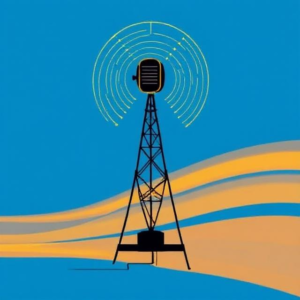RF and Microwave Engineering: An Easy Explanation
RF (Radio Frequency) and Microwave Engineering deals with the study and design of systems that use electromagnetic waves to transmit and receive information. These waves are used in a wide range of technologies, from radios and mobile phones to radar systems and satellite communication.
Let’s break down the concepts step by step:

1. What Are RF and Microwave Waves?
- RF Waves: These are electromagnetic waves with frequencies between 3 kHz to 300 GHz. They are used for communication purposes (e.g., AM/FM radio, TV signals, Wi-Fi).
- Microwaves: These are a subset of RF waves with frequencies between 300 MHz to 300 GHz, typically starting from 1 GHz. Microwaves are commonly used in radar, satellite communication, and microwave ovens.
2. How Do RF and Microwaves Work?
Electromagnetic waves (like RF and microwaves) travel through the air, space, or even cables to transmit signals. When you listen to the radio, for example, a station transmits an RF signal that your radio receiver picks up, decodes, and converts into sound.
- Transmitter: The device that sends the electromagnetic wave (e.g., a radio station).
- Receiver: The device that receives the signal and converts it back to usable information (e.g., your radio or smartphone).
3. Key Components of RF and Microwave Systems
- Antenna: It sends and receives electromagnetic waves. Different antennas are designed for different frequencies.
- For example, a TV antenna picks up RF signals from the air.
- Amplifiers: They boost weak RF/microwave signals. Without amplifiers, the signal would be too weak to reach its destination.
- Filters: These remove unwanted frequencies from a signal to ensure it’s clean and clear. This is important in communication systems to avoid interference.
- Oscillators: They generate RF or microwave signals at specific frequencies, like a radio frequency source.
- Mixers: These are used to combine two signals, often to shift the frequency of one signal to a different range (known as frequency conversion).
4. How Is RF and Microwave Engineering Used?
Applications of RF and Microwave Engineering are everywhere. Here are some examples:
- Communication Systems:
- Mobile Phones: They use RF waves to send and receive voice and data signals.
- Wi-Fi: Uses microwaves (around 2.4 GHz and 5 GHz) to provide wireless internet.
- Radar Systems:
- Used in air traffic control, weather forecasting, and even in cars for collision detection (like radar sensors).
- Satellite Communication:
- Satellites in space use RF/microwave frequencies to communicate with ground stations, transmitting TV, radio signals, and internet data.
- Microwave Ovens:
- These use microwaves at around 2.45 GHz to heat food by vibrating water molecules inside.
- Medical Imaging:
- RF and microwaves are also used in medical technologies like MRI (Magnetic Resonance Imaging).
5. Challenges in RF and Microwave Engineering
- Signal Interference: RF signals are prone to interference from other signals, such as nearby devices, buildings, or weather conditions.
- Power Loss: As the RF/microwave signal travels through space or cables, it loses strength, which can make communication less effective over long distances.
- Component Size and Cost: High-frequency components (like antennas, amplifiers, etc.) can become more complex and expensive as the frequency increases.
6. Why Is RF and Microwave Engineering Important?
- Connectivity: Almost all modern communication (phones, internet, TV, etc.) relies on RF and microwave technology.
- Safety and Navigation: In industries like aviation and defense, RF and microwave systems help ensure safety (e.g., radar for navigation) and security.
- Innovation: The development of faster communication systems (like 5G) and new technologies (like the Internet of Things) all depend on RF and microwave engineering.
7. Basic Concepts in RF and Microwave Design
Here are a few important principles:
- Frequency: The number of cycles a wave completes in a second. Higher frequencies carry more data but have a shorter range.
- Wavelength: The distance between two peaks of a wave. High-frequency waves have shorter wavelengths.
- Impedance: It’s how much a component resists or allows the flow of electric current at high frequencies. Matching impedances is important to ensure the signal doesn’t get reflected or lost.
- Reflection and Transmission: When a signal encounters an obstacle or change in medium, part of the signal may bounce back (reflection) or pass through (transmission).
Conclusion:
RF and Microwave Engineering is essential for understanding how wireless communication works. From radios and Wi-Fi to radar and satellite systems, RF and microwave waves are everywhere, helping us connect, communicate, and navigate. As technology evolves, RF and microwave engineers continue to design faster, more reliable systems, ensuring our world stays connected.











